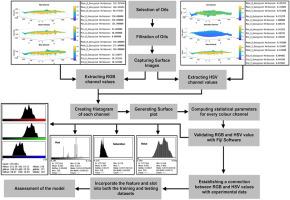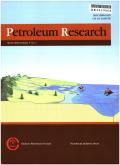A comparative experimental study on the prediction of renewable oils properties using RGB and HSV image processing techniques
IF 4
Q1 Earth and Planetary Sciences
引用次数: 0
Abstract
In this study, renewable oil properties of Flash Point (0C), Fire Point (0C), Density (kg/m3), Cloud Point (0C), Pour Point (0C), and Viscosity (cST) are predicted using image processing techniques of Red Green Blue (RGB) and Hue Saturation Value (HSV). Eleven types of renewable oils are chosen for experimentation, and their surface images are captured with a high-resolution digital camera. For better accuracy, around 150 surface images are captured for each oil sample, and their average pixel data is extracted using RGB and HSV techniques. The digital pixel information (metadata) of all the oil samples is mapped to their experimental oil properties, and the accuracy of the developed metadata is validated with Fiji software due to its better image analysis and also complex data quantifying capabilities. The minimum, maximum, mean, mode and standard deviation results of RGB and HSV agree with Fiji. In addition, the developed dataset has been validated with Neural Network classification and TreeBagger algorithms. The results of TreeBagger reveal that the trained dataset is highly accurate (91.9% for RGB and 95.3% for HSV). Similarly, 95.6% (RGB) and 97.3% (HSV) accuracy is achieved for Neural Network classification. Finally, two new oil surface images are trained using the developed dataset. Both RGB and HSV accurately predict the oil properties. Therefore, it is evident that predicting the significant oil properties helps optimize the production process by reducing experimental costs and time.

利用RGB和HSV图像处理技术预测可再生油品质的对比实验研究
本研究利用红绿蓝(RGB)和色相饱和度(HSV)的图像处理技术,预测了可再生油的闪点(0C)、燃点(0C)、密度(kg/m3)、浊点(0C)、倾点(0C)和粘度(cST)等特性。研究人员选择了11种可再生油进行实验,并用高分辨率数码相机捕捉到它们的表面图像。为了提高精度,每个油样捕获约150个表面图像,并使用RGB和HSV技术提取其平均像素数据。所有油样的数字像素信息(元数据)被映射到它们的实验油属性,并且由于斐济软件具有更好的图像分析和复杂的数据量化能力,因此开发的元数据的准确性得到了验证。RGB和HSV的最小值、最大值、平均值、众数和标准差结果与斐济一致。此外,开发的数据集已通过神经网络分类和TreeBagger算法进行验证。TreeBagger的结果表明,训练后的数据集具有很高的准确性(RGB为91.9%,HSV为95.3%)。同样,神经网络分类的准确率达到95.6% (RGB)和97.3% (HSV)。最后,利用开发的数据集对两幅新的石油表面图像进行训练。RGB和HSV均能准确预测油的性质。因此,很明显,预测重要的石油性质有助于通过降低实验成本和时间来优化生产过程。
本文章由计算机程序翻译,如有差异,请以英文原文为准。
求助全文
约1分钟内获得全文
求助全文
来源期刊

Petroleum Research
Earth and Planetary Sciences-Geology
CiteScore
7.10
自引率
0.00%
发文量
90
审稿时长
35 weeks
 求助内容:
求助内容: 应助结果提醒方式:
应助结果提醒方式:


